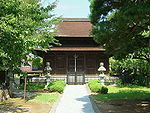
Seihaku-ji
Encyclopedia

Myoshin-ji
is a temple complex in Kyoto, Japan. The Myōshin-ji school of Rinzai Zen Buddhism is the largest school in Rinzai Zen. This particular school contains within it more than three thousand temples throughout Japan, along with nineteen monasteries. The head temple was founded in the year 1342 by the...
Rinzai school Zen
Zen
Zen is a school of Mahāyāna Buddhism founded by the Buddhist monk Bodhidharma. The word Zen is from the Japanese pronunciation of the Chinese word Chán , which in turn is derived from the Sanskrit word dhyāna, which can be approximately translated as "meditation" or "meditative state."Zen...
temple in Yamanashi
Yamanashi, Yamanashi
is a city located in Yamanashi Prefecture, Japan. In spite of the name, it is not the capital of the prefecture, which is Kofu.On June 1, 2011, the city had an estimated population of 37,927 with 14,453 households...
, Yamanashi Prefecture
Yamanashi Prefecture
is a prefecture of Japan located in the Chūbu region of the island of Honshū. The capital is the city of Kōfu.-Pre-history to the 14th century:People have been living in the Yamanashi area for about 30,000 years...
, Japan
Japan
Japan is an island nation in East Asia. Located in the Pacific Ocean, it lies to the east of the Sea of Japan, China, North Korea, South Korea and Russia, stretching from the Sea of Okhotsk in the north to the East China Sea and Taiwan in the south...
. It is said to have been founded in 1333 after a dream by Ashikaga Takauji
Ashikaga Takauji
was the founder and first shogun of the Ashikaga shogunate. His rule began in 1338, beginning the Muromachi period of Japan, and ended with his death in 1358...
. The temple was seriously damaged by fire in 1682.
The of 1415, a 3x3 bay
Ken (architecture)
A is a measurement in Japanese architecture. It has two principal uses:* As a proportion for intervals between the pillars of traditional-style buildings. The word is translated in this case in English as "bay". Traditional buildings usually measure an odd number of bays, for example 3×3 or 5×5...
structure with mokoshi
Mokoshi
In Japanese architecture a , literally "skirt story" or "cuff story", is a decorative pent roof surrounding a building below the true roof. Since it does not correspond to any internal division, the mokoshi gives the impression of there being more floors than there really are...
, was designated a National Treasure
National treasures of Japan
National Treasures are the most precious of Japan's Tangible Cultural Properties, as determined and designated by the Agency for Cultural Affairs...
in 1955. Its precise construction date was learned from items found during dismantling for repairs in 1917. Its was damaged by the 2011 Tōhoku earthquake
2011 Tōhoku earthquake and tsunami
The 2011 earthquake off the Pacific coast of Tohoku, also known as the 2011 Tohoku earthquake, or the Great East Japan Earthquake, was a magnitude 9.0 undersea megathrust earthquake off the coast of Japan that occurred at 14:46 JST on Friday, 11 March 2011, with the epicenter approximately east...
.
The of 1689-93 is representative of Edo period
Edo period
The , or , is a division of Japanese history which was ruled by the shoguns of the Tokugawa family, running from 1603 to 1868. The political entity of this period was the Tokugawa shogunate....
priests' quarters in the region and was designated an Important Cultural Property
Important Cultural Properties of Japan
The term is often shortened into just are items officially already classified as Tangible Cultural Properties of Japan by the Japanese Agency for Cultural Affairs and judged to be of particular importance to the Japanese people....
in 2005.
See also
- Japanese Buddhist architectureJapanese Buddhist architectureJapanese Buddhist architecture is the architecture of Buddhist temples in Japan, consisting of locally developed variants of architectural styles born in China...
- List of National Treasures of Japan (temples)

